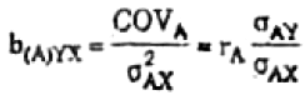Indirect Selection and Correlated Response | Animal Husbandry & Veterinary Science Optional for UPSC PDF Download
Correlated Response
- The expected response of a character Y when selection is applied to another character X is known as a related response. The response of character X ie, the character directly selected is equivalent to the mean breeding vai of selected individuals. The consequent change of character Y is therefore given by the regression of the breeding value of Y on the letting value of X.
The regression is  The response of character X, directly selected is
The response of character X, directly selected is
Rx = ihx σAx
Therefore, the related response of the character Y is or by putting σAx = hy σpv, the correlated response becomes
or by putting σAx = hy σpv, the correlated response becomes
- Hence, the anticipated outcome of a correlated character can be foreseen when armed with knowledge about the genetic correlation and heritabilities of both characters. Moreover, if the correlated response is observed through experimentation, along with known heritabilities for both characters, the genetic correlation can be approximated.
- To estimate the heritability of character Y as the realized heritability derived from the response to selection, a double-selection experiment becomes imperative. This involves selecting character X in one line and character Y in another, allowing for the measurement of both the direct and correlated responses for each character.
- Such experiments yield two estimates of the genetic correlation, one from the correlated response of each character. These estimates should align if the theory of correlated responses, as articulated in equation (3) above, accurately encapsulates the observed responses. A consolidated estimate of the genetic correlation can be derived from double selection experiments, eliminating the need for heritability estimates through the following formula, easily deduced from equation (2) above.

- Achieving close concordance between observed and predicted correlated responses is not always guaranteed and, in fact, is infrequently encountered, especially when the genetic correlation is low. Additionally, double selection experiments tend to be unreliable in providing consistent estimates of the genetic correlation. Two primary factors contribute to the diminished predictability and the inconsistency of correlated responses. The first factor is the low precision inherent in estimating the genetic parameters.
Genetic Correlations and Selection Strategies in Breeding Programs
The effectiveness of correlated responses in breeding programs can be compromised due to large sampling errors and the sensitivity of genetic correlations to gene frequency changes. These factors introduce uncertainties in applying the theory of correlated responses in practical breeding scenarios.
Direct vs. Indirect Selection:
Indirect selection involves choosing one trait to enhance the improvement of another. While generally less effective than direct selection, the efficiency ratio (CR/Rx) determines the merit of indirect selection. Indirect selection can outperform direct selection if the secondary trait has higher heritability and a stronger genetic correlation with the desired trait.
Conditions for Indirect Selection:
Indirect selection is applied under specific circumstances, such as when the desired trait is challenging to measure directly with precision or when one trait is measurable in only one sex. A combination of direct and indirect selection is often more valuable in practice.
Genotype and Environmental Interaction:
Genotype and environmental interaction highlight that the best genotype in one environment may not excel in another. Consideration of environmental differences is crucial, especially when making breed improvements. Genetic correlations provide a basis for addressing challenges related to environmental differences in breeding policies.
Environmental Influence on Genetic Correlations:
When measuring the same trait in different environments, it is essential to treat them as distinct characters due to differences in physiological mechanisms and required genes. Understanding heritability and genetic correlations helps address challenges arising from environmental variations.
Genetic Selection and Environmental Impact on Livestock Traits
Understanding the interplay between genetic factors and environmental conditions is crucial in optimizing livestock traits. The effectiveness of gene selection in different environments depends on the correlation between traits, with low diversity requiring distinct gene sets for optimal performance.
Indirect Selection Dynamics:
Examining the transferability of improvements across environments poses challenges. For example, selecting for growth rate (X) on a high-nutrition plane may not directly enhance growth rate (Y) on a low-nutrition plane. The correlated response, measured as CRAPY, is a critical factor in assessing the success of indirect selection.
Comparing Selection Approaches:
The efficacy of indirect selection hinges on factors like r and by, where its superiority is evident when these factors surpass bX. The adaptability of the population to its destined environment plays a pivotal role. Low adaptability makes selection in the destined environment advantageous.
Experimental Insights:
Fowler and Enaminger's study on swine selection using an index, emphasizing the gain ratio, highlighted the influence of nutrition on growth. Danish Landrace xChesterwhite crossbreeds were divided into fully-fed and restricted lines. Selection for rate of gain in both lines closely aligned with expectations. Genotype-environment interactions were observed, with the more rigorous condition line performing well in both environments.
Mice Selection Experiments:
Experiments by Falconer on mice under unrestricted and restricted diets indicated that selecting on a restricted diet enhanced genetic potential for growth under both regimes. However, the reverse scenario was less effective. While genotype-environment interactions were present, their practical importance was limited.
Concluding Remarks:
Available evidence suggests that adaptation is generally applicable across traits, with only a few exceptions. Genetic differences are more pronounced in favorable environments, underscoring the significance of selecting under conditions resembling those of commercial animals.
FAQs on Indirect Selection and Correlated Response - Animal Husbandry & Veterinary Science Optional for UPSC
| 1. What is genetic correlation and how does it impact breeding programs? |  |
| 2. How do selection strategies in breeding programs take genetic correlations into account? |  |
| 3. What is the impact of environmental factors on livestock traits in genetic selection? |  |
| 4. How does indirect selection work in breeding programs? |  |
| 5. How does correlated response contribute to the success of breeding programs? |  |




















